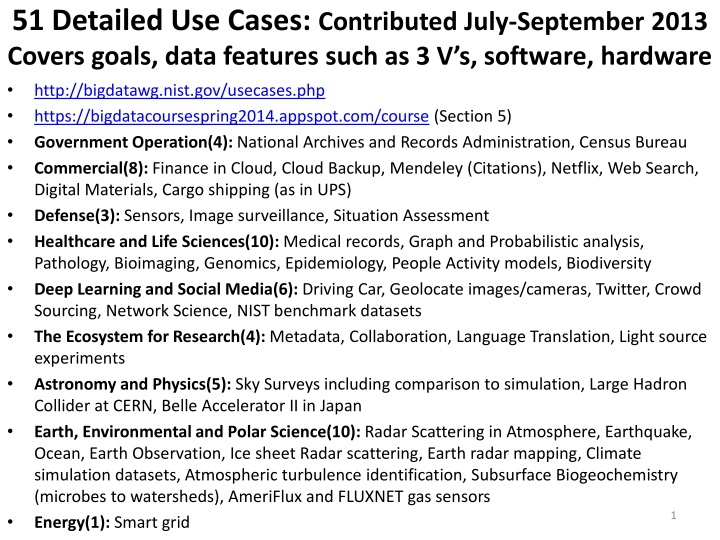
Big Data Use Cases and Ecosystem Insights
Explore a comprehensive overview of diverse use cases covering government operations, commercial sectors, defense, healthcare, deep learning, research ecosystems, astronomy, physics, environmental science, and more. Learn about the Enhanced Apache Big Data Stack capabilities and insights from experts in the field. Discover the facets of Big Data Ogres and their impact on core analytics kernels. Gain valuable lessons and integration tips from renowned professionals in the industry.
Download Presentation

Please find below an Image/Link to download the presentation.
The content on the website is provided AS IS for your information and personal use only. It may not be sold, licensed, or shared on other websites without obtaining consent from the author. If you encounter any issues during the download, it is possible that the publisher has removed the file from their server.
You are allowed to download the files provided on this website for personal or commercial use, subject to the condition that they are used lawfully. All files are the property of their respective owners.
The content on the website is provided AS IS for your information and personal use only. It may not be sold, licensed, or shared on other websites without obtaining consent from the author.
E N D
Presentation Transcript
51 Detailed Use Cases: Contributed July-September 2013 Covers goals, data features such as 3 V s, software, hardware http://bigdatawg.nist.gov/usecases.php https://bigdatacoursespring2014.appspot.com/course (Section 5) Government Operation(4): National Archives and Records Administration, Census Bureau Commercial(8): Finance in Cloud, Cloud Backup, Mendeley (Citations), Netflix, Web Search, Digital Materials, Cargo shipping (as in UPS) Defense(3): Sensors, Image surveillance, Situation Assessment Healthcare and Life Sciences(10): Medical records, Graph and Probabilistic analysis, Pathology, Bioimaging, Genomics, Epidemiology, People Activity models, Biodiversity Deep Learning and Social Media(6): Driving Car, Geolocate images/cameras, Twitter, Crowd Sourcing, Network Science, NIST benchmark datasets The Ecosystem for Research(4): Metadata, Collaboration, Language Translation, Light source experiments Astronomy and Physics(5): Sky Surveys including comparison to simulation, Large Hadron Collider at CERN, Belle Accelerator II in Japan Earth, Environmental and Polar Science(10): Radar Scattering in Atmosphere, Earthquake, Ocean, Earth Observation, Ice sheet Radar scattering, Earth radar mapping, Climate simulation datasets, Atmospheric turbulence identification, Subsurface Biogeochemistry (microbes to watersheds), AmeriFlux and FLUXNET gas sensors Energy(1): Smart grid 1
Enhanced Apache Big Data Stack ABDS+ 114 Capabilities Green layers have strong HPC Integration opportunities Functionality of ABDS Performance of HPC
Big Data Ogres and Their Facets from 51 use cases The first Ogre Facet captures different problem architecture . Such as (i) Pleasingly Parallel as in Blast, Protein docking, imagery (ii) Local Machine Learning ML or filtering pleasingly parallel as in bio-imagery, radar (iii) Global Machine Learning seen in LDA, Clustering etc. with parallel ML over nodes of system (iii) Fusion: Knowledge discovery often involves fusion of multiple methods. The second Ogre Facet captures source of data (i) SQL, (ii) NOSQL based, (iii) Other Enterprise data systems (10 at NIST) (iv)Set of Files (as managed in iRODS), (v) Internet of Things, (vi) Streaming and (vii) HPC simulations. The third Ogre Facet is distinctive system features such as (i) Agents, as in epidemiology (swarm approaches) and (ii) GIS (Geographical Information Systems). The fourth Ogre Facet captures Style of Big Data applications. (i) Are data points in metric or non-metric spaces (ii) Maximum Likelihood, (iii) 2minimizations, and (iv) Expectation Maximization (often Steepest descent). The fifth Facet is Ogres themselves classifying core analytics kernels (i) Recommender Systems (Collaborative Filtering) (ii) SVM and Linear Classifiers (Bayes, Random Forests), (iii) Outlier Detection (iORCA) (iv) Clustering (many methods), (v) PageRank, (vi) LDA (Latent Dirichlet Allocation), (vii) PLSI (Probabilistic Latent Semantic Indexing), (viii) SVD (Singular Value Decomposition), (ix) MDS (Multidimensional Scaling), (x) Graph Algorithms (seen in neural nets, search of RDF Triple stores), (xi) Learning Neural Networks (Deep Learning), and (xii) Global Optimization (Variational Bayes).
Lessons / Insights Geoffrey Fox , Judy Qiu (Indiana), Shantenu Jha (Rutgers) Please add to set of 51 use cases Integrate (don t compete) HPC with Commodity Big data (Google to Amazon to Enterprise data Analytics) i.e. improve Mahout; don t compete with it Use Hadoop plug-ins rather than replacing Hadoop Enhanced Apache Big Data Stack ABDS+ has 114 members please improve! There is a lot more than Hadoop in ABDS 6 zettabytes total data; LHC is ~0.0001 zettabytes (100 petabytes) HPC-ABDS+ Integration areas include file systems, cluster resource management, file and object data management, inter process and thread communication, analytics libraries, workflow and monitoring Ogres classify Big Data applications by five facets each with several exemplars Guide to breadth and depth of Big Data Does your architecture/software support all the ogres?
